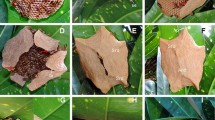Summary
The nest expansion behavior ofNasutitermes costalis, a common Neotropical arboreal termite, was analyzed by means of direct and photographic observation of a thriving laboratory colony over a 45-month period. 52 expansion episodes were recorded, each resulting in the addition of as much as 10% to the nest volume. The expansion process can be divided into 3 phases Initiation, Building, and Termination. Termination results in a nest surface whose shape focuses initial building efforts during the Initiation of subsequent expansion. Building consists almost entirely of multiple repetitions of a few simple architectural elements — primarily the branching of one wall into two and the joining of neighboring walls via a bridge — all occurring on a smooth “active surface” which persist throughout each expansion episode. Interesting similarities between certainN. costalis nest expansion architectural features and structures builtde novo by queened termite groups from 3 subfamilies of the Termitidae suggest that this is a relatively primitive mode of nest expansion.
Resume
Les mécanismes d'acroissement du nid deNasutitermes costalis, ont été analysés par l'observation directe et par la photographie d'une colonie prospère, élevée au laboratoire pendant plus de 45 mois. Nous avons enregistré 52 périodes d'accroissement, chacune entraînant une augmentation de 10% du volume du nid. On peut diviser le processus d'accroissement du nid en 3 phases: la phase initiale, la phase de construction, la phase finale. La phase finale aboutit à une surface dont la forme traduit la convergence des premiers efforts de construction pendant la phase initiale d'accroissement. La construction est basée presque entièrement sur des répétitions multiples d'un petit nombre d'éléments architecturaux simples, essentiellement la division, d'un mur en deux embranchements et la réunion de murs voisins au moyen d'un pont. Tout cela se passe sur une “surface active” lisse qui demeure ainsi tout le temps de chaque période d'accroissement. Les intéressantes similitudes entre certains traits architecturaux de l'accroissement du nid deN. costalis, et certaines structures construites «de novo» par des groupes de termites avec une reine et appartenant à trois sous-familles de Termitidae suggèrent que le mode d'accroissement du nid deN. costalis est relativement primitif.
Similar content being viewed by others
References
Beaumont J., 1889. InDudley P.H., 1889. — Observations on the termites, or white ants, of the isthmus of Panama.Trans. New York Acad. Sci., 8, 85–114.
Emerson A.E., 1938. — Termite nests — a study of the phylogeny of behavior.Ecol. Monographs, 8, 247–284.
Emerson A.E., 1956. — Regenerative behavior and social homeostasis of termites.Ecology, 37, 248–258.
Frisch K. von, 1974. — Animal Architecture.harcourt Brace Jovanovich, New York, VI + 306 p.
Grassé, P.P., 1959. — La reconstruction du nid et les coordinations interindividuelles chezBellicostermes natalensis etCubitermes sp. La théorie de la stigmergie: essai d'interprétation du comportement des termites constructeurs.Ins. Soc., 6, 41–80.
Grassé P.P., 1967. — Nouvelles expériences sur le termite de Müller (Macrotermes mulleri) et considérations sur la théorie de la stigmergie.Ins. Soc., 14, 73–102.
Howse P.E., 1966. — Air movement and termite behavior.Nature, 210, 967–968.
Jones R.J., 1977. — The Building Behavior of ArborealNasutitermes. Doctoral Thesis,Harvard University, Cambridge, Mas., 413 p.
Jones R.J., 1980. — Gallery Construction byNasutitermes costalis: Polyethism and the Behavior of Individuals.Ins. Soc. (in press).
Mc Mahan E.A. 1970. — Polyethism in workers ofNasutitermes costalis.Ins. Soc., 17, 113–120.
Noirot C., 1970. — The nests of termites. InKrishna K., Weesner F.M., eds., Biology of Termites, Vol. II.Academic Press, New York, pp. 73–126.
Sands W.A., 1961. — Nest structure and size distribution in the genusTrinervitermes (Isoptera, Termitidae, Nasutitermitinae) in West Africa.Ins. Soc., 8, 177–188.
Shulman H.M., 1975. — The effects of population size and worker-soldier ratio on the building behavior ofNasutitermes costalis (Holmgren). Undergraduate thesis,Harvard College, Cambridge, Mas., 36 p.
Stuart A.M., 1967. — Alarm, defense, and construction behavior relationships in termitesScience, 156, 1123–1125.
Stuart A.M., 1969. — Social behavior and communication. InKrishna K., Weesner F.M., Ed., Biology of Termites, Vol. I.Academic Press, New York, pp. 193–232.
Stuart A.M., 1972. — Behavioral regulatory mechanisms in the social homeostasis of termites (Isoptera).Am. Zoologist, 12, 589–594.
Wilson E.O., 1971. — The Insect Societies.Harvard University Press, Cambridge, Mas., X + 548 p.
Wilson E.O., 1975. — Sociobiology, The New Synthesis.Harvard University Press, Cambridge, Mas., IX + 697 p.
Author information
Authors and Affiliations
Rights and permissions
About this article
Cite this article
Jones, R.J. Expansion of the nest ofNasutitermes costalis . Ins. Soc 26, 322–342 (1979). https://doi.org/10.1007/BF02223552
Received:
Accepted:
Published:
Issue Date:
DOI: https://doi.org/10.1007/BF02223552




